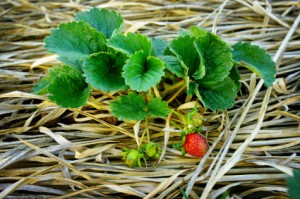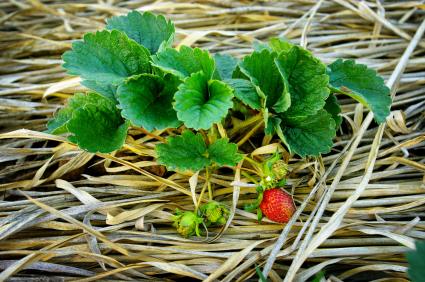Strawberries are a great addition to any garden, but they do require special care and attention, especially in the winter. To keep your plants healthy and producing for many seasons, you will want to prepare them well for the winter season.
Strawberry Plants Left in the Ground
 In the fall, remove weak plants from your strawberry patch. Dig up plants with the fewest leaves to let the larger, more productive plants have plenty of room to grow.
In the fall, remove weak plants from your strawberry patch. Dig up plants with the fewest leaves to let the larger, more productive plants have plenty of room to grow.- Search through your beds for runners; these look like vines that spread out from the main plants. Cut off those that do not have roots along their length. They will not have time to root before frost kills them.
- Mow or cut plants back to an inch in height.
- In late fall or early winter, after the ground begins to freeze, cover plants with a four-inch layer of loose mulch, like straw or leaves. Waiting for the ground to begin freezing gives them time to adapt to lower temperatures.
- As spring comes on, gradually remove the mulch over about a month’s time. Keep mulch close at hand so you may re-cover plants if there is a late frost.
- Frost damage that can’t be repaired can happen if the temperature drops to 15°F. Plants must be mulched before this.
Storing Your Strawberries Indoors
If you are splitting up your strawberries to give them room to grow next year or moving them to a new location next spring and are wondering how to go about it, I may have your solution. I am thinning my strawberry bed and laying down a drip irrigation system, so I needed a way to store the plants while I put down the tubing and refreshed the soil for next year. So I found some information on a site that I used to put together this storage method for home use.
- Water your bed well just prior to removing the plants.
- Carefully dig up plants and place them into small pots (3” to 4” diameter).
- Place a layer of straw, Spanish moss, or burlap into the bottom of a gallon-size zippered storage bag.
- Place two of your pots into each gallon bag, surround the plants with more hay or moss to insulate the plants, and zip closed, retaining as much of the air as possible.
- Place zippered bags into a box, surrounding them with more hay or moss.
- Clear a place for your box(es) in your freezer. In an upright freezer, place a layer of newspaper, burlap or other insulation on the shelf before placing your box(es) on it. In a chest freezer, place 2x4s (or other spacers) on the floor of the freezer to keep your box(es) from touching it.
- If you live in a colder climate, you can store your boxes in an unheated garage, shed, or basement once the weather has turned frigid. Wherever you store them, the temperature must remain at freezing or below until it is time to set them out again.
- Stack boxes together to help them insulate each other. You should also keep them from touching sides of the freezer to preserve your plants.
- Take your plants out to water sparingly once a month. This will keep them from drying out. Moisten soil only; avoid drenching so the plants don’t rot.
- If your berries grow in a large container that is too heavy to move, you can place a layer of straw around and over the container, then wrap that with a layer of burlap and tie the burlap in place to keep it from blowing away.
Replanting Strawberries
- Plant in early spring, as soon as the ground can be worked.
- Make holes deep and wide enough for the whole root system to fit without bending, but not too deep. Roots should be no longer than eight inches when set out. If necessary, trim them.
- Cover roots well, but place the crown at surface level of the soil.
- Check soil for pH level; it should be slightly acidic to neutral (5.5 – 7.0) for the sweetest berries.
- Give them room to grow; place plants eighteen to twenty-four inches apart. If growing in rows, set them thirty-six to forty-eight inches apart.
- Grow strawberries in direct sunlight, as they require six to ten hours of full sun daily.
- Strawberries are tolerant to many soil types, but they love a loamy, well-drained soil. Begin working in aged manure or compost about two months before you plant. A raised bed makes a perfect atmosphere for the berry patch.
- Rotate crops for greatest success. Do not plant this year’s patch in a bed that held strawberries, tomatoes, peppers, or eggplant in the last three years.
New DVD shows you all the basics and techniques of preserving this years harvest…
Care
- In the first season, pull off all blossoms to encourage a healthy root system. While prevented from fruit bearing, it allows them to spend more energy in root building.
- Watering is extremely important due to their shallow root system. Water well, about an inch or more weekly.
- Weed the beds diligently by hand, especially in the first months after planting.
- When the growing season has ended, mow or cut back the foliage to an inch tall. Add straw, leaves or other organic matter to a depth of four to six inches; the colder your region, the more mulch will be needed.
- Use row covers to protect the blossoms and fruit from birds.
Pest Prevention and Control
- Grey Mold – lives on dead plant matter. It is common to all garden areas. Temperatures of 70 to 80°F and moisture are perfect habitat for its growth. Non-chemical control includes hygiene and reducing humidity. Proper spacing of plants allows for airflow, as does keeping weeds under control and thinning plants regularly. Also, do not apply high-nitrogen content fertilizer in the spring, as it helps to produce thick foliage, which prevents the quick drying of your berries. Don’t over-water, and remove all dead and dying plants quickly. You will also want to keep weeds in check.
- Powdery Mildew – starts off as powdery, circular white spots, usually covers the leaf uppers and affects the older leaves first turning them yellow and drying them out. Symptoms appear late in the growing season and will cause the leaves, buds and growing tips to become distorted showing the symptoms above. Prevention comes by avoiding plant crowding and over watering. Non-chemical control includes: removing all infected plant parts and destroy them – remember not to put them into your compost as it can be spread throughout your garden by the wind. You might also spray plants with an organic fungicide. A simple recipe for such a fungicide is 1 teaspoon of baking soda mixed in a quart of water. Spray plants thoroughly.
- Japanese Beetles – a small bug that poses a large threat. These pests are half an inch long and metallic blue-green with tan wings and small white hairs lining the sides of the abdomen. They lay eggs in the soil in June that will develop into tiny, white grubs that overwinter in the soil and emerge as adult beetles in June. They will immediately begin munching on your plants, attacking in groups and causing severe damage. Their adult lifespan is a short forty days, but they can cover a lot of ground and leave your garden looking like a maze of skeletonized leaves– only their veins remaining. To rid your garden of the beetles:
- Spray your soil’s surface with a solution of dish soap and water in late spring; dilution should be two tablespoons of soap to a gallon of water. This will bring the grubs to the soil’s surface – birds will love you for the free meal. Continue spraying weekly until you no longer have grubs surfacing when you spray.
- If you get mature bugs, the best way to get rid of them is to hand pick them off your plants. If you remain diligent this will work, but it is time consuming.
- Apply parasitic nematodes following package directions. Drench the soil around the problem area.
- Neem oil sprays and sprays that contain potassium bicarbonate are somewhat effective.
- Place a drop cloth under your plants early in the morning, when they’re most active, and shake them off the plants. Dump them into a bucket of soapy water and they will not survive.
- Spider Mites – about the size of a poppy seed and a member of the spider family. They insert a tube into the plant and suck out its juices. These mites mature rapidly, in about two weeks time. The females can lay thousands of eggs in their lifetime, which will hatch in about three days. They live on the underside of leaves and can be overlooked in the garden. Your first notification that they have arrived is usually the sight of tiny, brown spots circled by small yellow areas; which indicate the sites where they have used their proboscises to puncture the leaf and suck the plant’s life juices out. As they multiply, they begin web building to travel from plant to plant. To kill the mites, spray them with an organic pesticide containing pyrethrum. You can also make an herbal tea insecticide. Heat a tablespoon each of ground cinnamon and ground cloves along with two tablespoons of Italian seasonings in a quart of water until it comes to a simmer, then remove from heat. When tea is slightly cooled, add two tablespoons of crushed fresh garlic and continue cooling to room temperature. Strain through a coffee filter, and then add a few drops of dish soap or liquid hand soap. Spray on the underside of the infested leaves every three days to rid the garden of your mite problem. They will be gone within two weeks time.
Varieties
Plant more than one variety, as each responds to different conditions. This will give you a wide range of fruit to enjoy.
- Northeaster is best grown in the northeastern U.S. and southern Canada. The berries have a strong aroma and flavor.
- Sable is hardy to zone 3. It is an early-season variety with great flavor.
- Cardinal is a good variety to try in the South.
- Camarosa is a great West Coast variety.
- Primetime is a mild-flavored and disease-resistant variety. It is best adapted to the Mid-Atlantic region.
Love your berries and care for them well, and they will give you delicious fruit for years to come. Happy gardening!



 In the fall, remove weak plants from your strawberry patch. Dig up plants with the fewest leaves to let the larger, more productive plants have plenty of room to grow.
In the fall, remove weak plants from your strawberry patch. Dig up plants with the fewest leaves to let the larger, more productive plants have plenty of room to grow.







